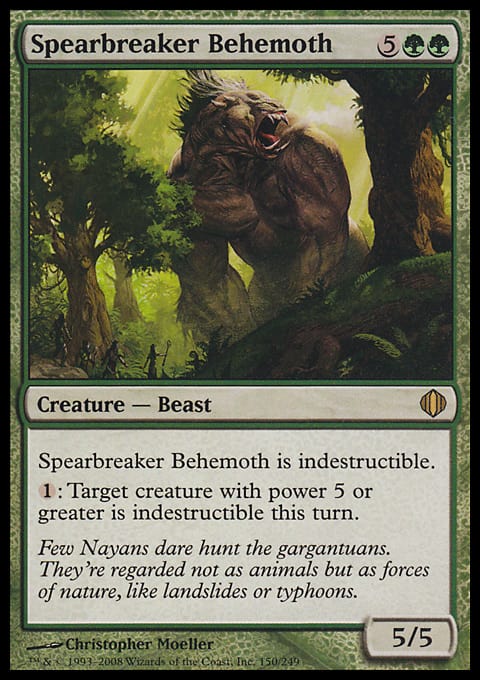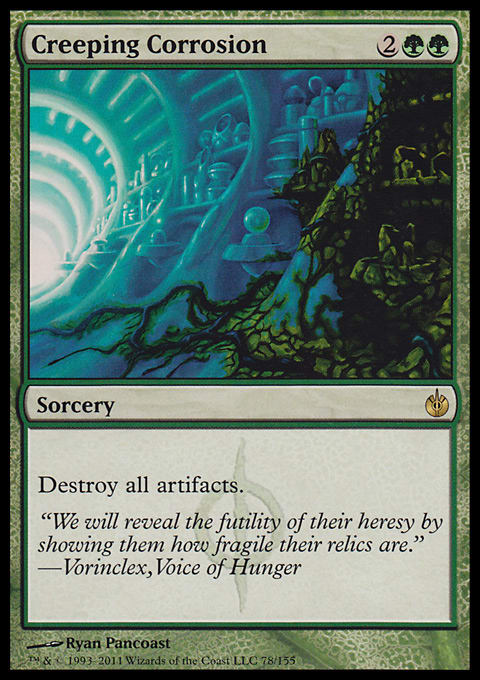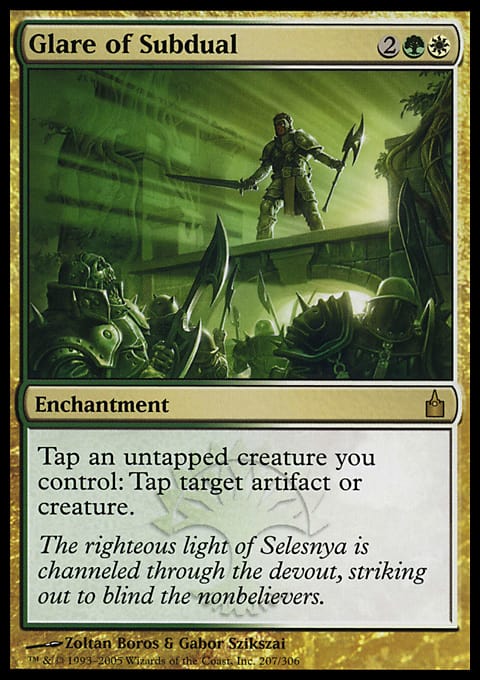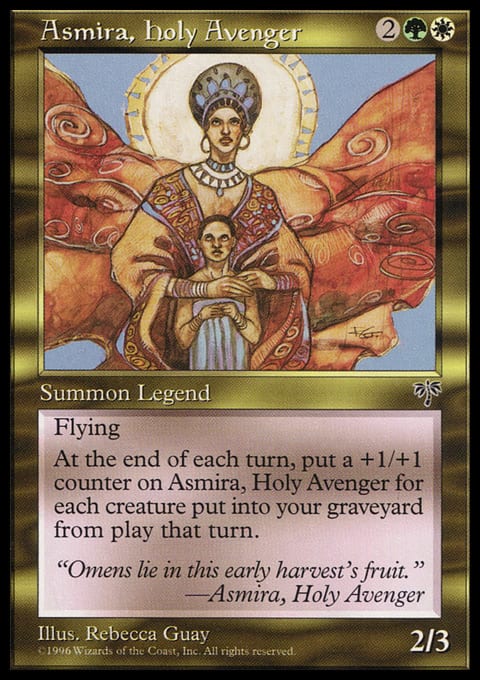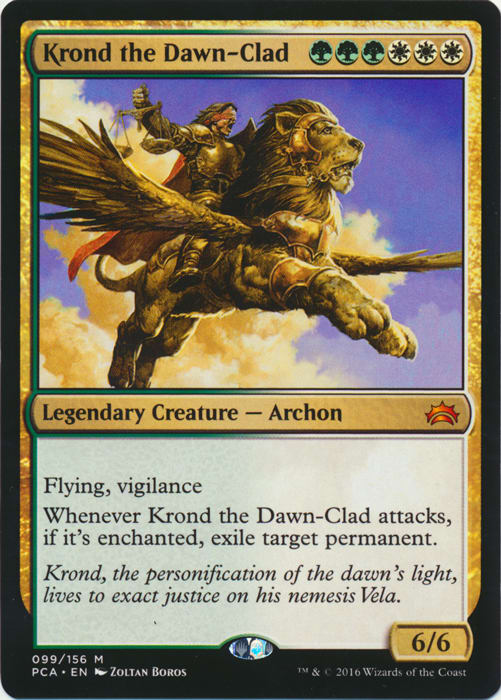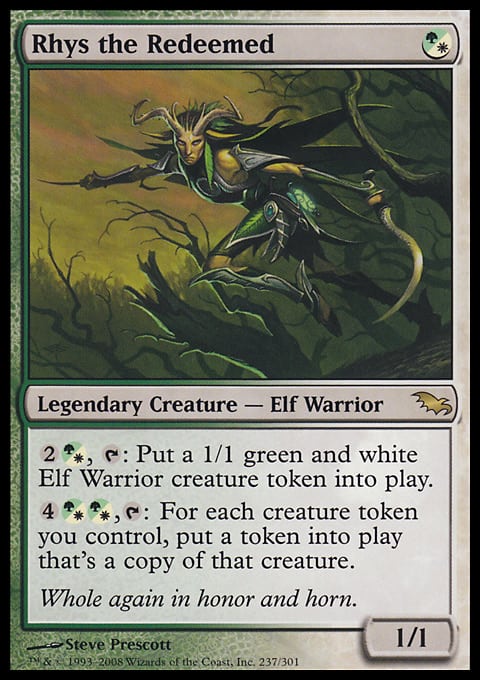Welcome to the third part of my Return to Ravnica lead-in series. Whether you’ve never been to Ravnica before or have just been away for a while, I'm trying to provide an overview of what each guild brings to the table in terms of Commander. Of course, if you’ve read my Azorius and Rakdos previews, you know that already, so let’s get on with the show!
Strengths
Selesnya is the guild of life, harmony, and community. If you liked the all-for-one theme of Bant, you’ll love life in the hippy commune that is Selesnya.
All in the Family
Green and white sit on the intersection of making a lot of critters and pumping a lot of critters. Selesnya in particular was all about the critters, with a strong token-generation theme and a mechanic, convoke, that let you accelerate into some crazy stuff early on.1 One of my favorite involved Llanowar Elves into Fists of Ironwood into Scatter the Seeds into Guardian of Vitu-Ghazi. That’s a 4/7 with vigilance on turn four whether or not you even made your third land drop. Later on, I added Manaplasm to the deck because it gets +8/+8 no matter how you cast the Guardian.
You Should Always Have Protection
We’ve come a long way from Giant Growth and the various Ward Auras in Alpha, but the theme remains the same. White still has protection, green has hexproof, both colors are now the masters of pump, and indestructibility is now shared between green, white, and artifacts. With Selesnya, Plan A will almost always be the beatdown, and that’s why cards such as Dauntless Escort, Spearbreaker Behemoth, Faith's Reward, and the not-quite-officially-spoiled Rootborn Defenses are so game-breaking. A Selesnya deck that protects its board presence with cards like these is probably going all the way.
Under the Rug
Selesnya has an option that only one other guild does: to dominate with creatures while denying opponents the ability to generate value from artifacts and enchantments. Whether you use sweepers like Purify and Creeping Corrosion, spot removal like Return to Dust and Stomp and Howl, or creatures like Uktabi Orangutan and Cloudchaser Kestrel, Selesnya can deny its opponents a broad swath of resources. Often, what seems like a big, dumb, beatdown strategy can actually be a more sophisticated form of aggro/control that shapes the battlefield in a way that is toxic to two of the most common classes of permanents.
Weaknesses
Like Azorius, Selesnya is pretty tight; they don’t have much in the way of permission, but they can handle anything else. Green even has reach through cards like Squall Line and other Hurricane variants (which combo nicely with green’s ramp and white’s life-gain). Typical Selesnya builds are quite focused on their ground game, though, and if you can keep a Selesnya player’s board presence manageable, he’ll struggle to win.
One of the curious things about G/W is that while green is the color of ramp and white has its own ramp—stuff like Tithe, Knight of the White Orchid, and Weathered Wayfarer would make most other colors jealous—green’s ramp is so good that white can't really add anything. Notice how this contrasts with Rakdos, wherein the blood and explosion themes from both colors synergize much better. If ever there was a sign that green ramp is a tad too strong, this might be it.
That isn’t the only area of non-synergy for Selesnya. Selesnya builds inevitably lose some of the advantages of white’s sweepers by running a large number of creatures, and even green’s ability to sweep the skies can be hampered by the fact that white has some of the best flyers in the game.
Hidden Gems
Aura Shards – Let’s start off with something that is well known to almost all of GatheringMagic readers but that is so supercalifragilistic that it is worth mentioning even if there’s only one person who hasn’t seen it yet. This is probably the first card I put into any deck that can run it, and I don’t think there is anything I’d rather drop on the third turn of a multiplayer game (it also works on the third turn of a duel against a ferocious Sharuum combo deck).
Behemoth Sledge – Armadillo Cloak isn’t exactly a secret at this point, but I believe the Equipment version is underplayed. As a variant of Armadillo Cloak, it is almost strictly better on account of not being an enchantment, but you could just as easily consider it as a variant of the beloved Loxodon Warhammer. Even though the Warhammer is among the best pieces of Equipment in multiplayer and arguably the best that doesn’t have “Sword” in the name, Behemoth Sledge can be better if you’re in those colors just because it boosts the survivability of your creatures.
Congregation at Dawn – Just as a general rule of thumb, if any card makes the Mirage tutors look anemic by comparison, it’s pretty freaking good. Congregation at Dawn gives you the kind of creeping inevitability that we all crave, and as an instant-speed tutor, you’re going to be playing your first creature before most opponents have a chance to react. With so many answers in creature form (Acidic Slime, Woodfall Primus, Archon of Justice, and Voidstone Gargoyle to name a few), there isn’t much this congregation can't do. Eladamri's Call is similar, but I still prefer the Congregation.
Dauntless Escort – I mentioned it before, but it’s too good not to mention again. Sweepers can often change the whole course of a game, and so being able to protect your doodz can swing things back your way. To me, the number of times an Iron Rhino in a graveyard becomes a prime reanimation target is proof of how powerful it is.
Dueling Grounds – A control classic, Dueling Grounds doesn’t work so well with the usual teeming weenie hordes, but Selesnya is equally capable of winning with quality of creatures as well as quantity.
Fracturing Gust – Gust gets rid of everything, including your own stuff, but at least you’ll get a buttload of life from it (“Sorry I blew up my stuff. Here’s some gold”). There aren’t many sweepers that you can play at instant speed, but considering that even a sorcery like Creeping Corrosion is highly playable in Commander, the advantages of the Gust are obvious. And the best thing is that thanks to the hybrid mana cost, you can play it in a three-color deck without any trouble.
Glare of Subdual – This card defined Standard when Ravnica first came on the scene, but I’ve only seen one guy run it (other than me) in Commander. Tappers such as Icy Manipulator can come in handy when fending (protecting against an onslaught from a single player) and homing (focusing all of your energy on ousting a single player)2 but are otherwise relatively weak in multiplayer. The reason is that you have to tap a creature down before it is announced as an attacker, meaning that you often don’t know which creatures to use your limited tapping resources on. Glare gives you a lot more options, and with a token deck, you can easily tap down everything that worries you every turn.
Hunting Grounds – “You may put a creature card from your hand onto the battlefield.” That’s a very unusual ability, and it’s even rarer on a permanent. My B/G/W Teneb deck actually runs very few creatures, and a lot are utility weenies, so I find Deathrender more valuable there as sweeper insurance, and my Krond deck (see the list at the end of the article) favors enchantments over creatures, but most G/W or G/W/x decks will love Hunting Grounds. Enjoy both the way it powers out your army while leaving your mana open for spells and the way your opponents are forced to play around it.
Juniper Order Ranger – Selesnya really did well out of the persist mechanic from Shadowmoor, and the Ranger allows you to basically go infinite with any of them; Woodfall Primus, Twilight Shepherd, Kitchen Finks, and others just go bonkers with this card. Plus, he can become a pretty hefty beater in his own right, especially if you’re playing tokens.
Mystic Enforcer – It literally pains me to recommend a pro-black creature, but the Nomad Leg-breaker is fantastic value at 4 mana for a 6/6 flyer, with or without protection from the best color in the game.
Lands – Finally, it seems that Selesnya has done very well in the specialty lands dept, starting with Judgment. Riftstone Portal, Krosan Verge, Nantuko Monastery, Vitu-Ghazi, the City-Tree, Stirring Wildwood, and Gavony Township all play very well in Commander.
Meet the Boss
Crap
Sir Shandlar of Eberyn – A vanilla 4/7? Two words: Elesh Norn.
Kei Takahashi – It’s Super Samite Healer! But Samite Healer sucks.
Lord Magnus – We live in a world of 4/4s for 4 mana with special abilities to boot. A 4/3 for 6 with two almost entirely irrelevant abilities outweighs the coolness of being Lord Magnus.
Gabriel Angelfire – 7 mana for a 4/4 Angel is just too steep, although if you are going to give this androgynous-looking redhead a try, I recommend going with rampage 3 and a Lure or Indrik Umbra.
Torsten Von Ursus – He has the helmet wings for a Captain America theme deck . . . that’s all I’ve got.
Lady Caleria – Dealing 3 damage to a creature is decent, but it doesn’t mean too much in Commander. There is nothing you can do with 3 damage that your opponents can't play around.
Jasmine Boreal – Paying 5 for a vanilla 4/5 doesn’t completely suck, but when you consider the possibility of cards such as Ant Queen, Indrik Stomphowler, and Elderwood Scion, she’s just not getting it done.
Fair to Middlin’
Asmira, Holy Avenger – Asmira did benefit from an early episode of Entourage on CommanderCast, but for all that, I don’t think she quite makes the cut into the Johnnyable category. Asmira can totally kick ass if the stars align, but her ceiling is a little too low, and if you really want to push the mechanic, you should be playing black or Golgari, which are capable of taking it much further than Selesnya can.
Chorus of the Conclave – Anyone who played the Counter-Punch Commander precon deck last year is likely to remember the Chorus. In the late game with plenty of mana, it can turn a Birds of Paradise into a must-answer threat. The two drawbacks are that it costs a whole boatload of mana and that your opponents will quickly realize that they need to kill the Chorus ASAP rather than wait for other creatures to also become threatening. Also, I believe this might be among the weirdest commander choices in the game—is it just me or is it actually a song rather than a person or group!?
Tolsimir Wolfblood – Wolves are cool; that alone is plenty of reason to play him. The guild Crusade effect is pretty damn cool as well, although in a post-Wilt-Leaf Liege-and-Elesh Norn, Grand Cenobite world, that isn’t quite impressive. Bottom line: Tolsimir isn’t particularly powerful, but he more than makes up for it by bringing style.3
Just Johnnyable
Krond the Dawn-Clad – I've heard a lot of smack about Krond, mainly along two lines: The mana cost is too intimidating, and Krond is weaker in an enchantment-based deck than Uril, the Miststalker. Now, the first point is just rubbish; by turn six, a green deck can have any amount of mana it wants. Put a Cultivate, a Kodama's Reach, and a couple of those 4-drop land-fetchers in your deck, and the problem will take care of itself. And if that isn’t enough, white has a couple of good accelerants, a la Tithe and Weathered Wayfarer as well.
The second criticism has some teeth to it, but in my experience, Uril is too strong. Shroud and hexproof in Commander just discourage interaction, and the combination of Uril, Runes of the Deus, and any other enchantment can be a real downer. Krond may be a little too vulnerable to your opponents’ interactions, but I’d still rather bring a Krond deck to a casual table than an Uril deck. In fact, I put my money where my mouth is by making Krond my first Selesnya commander.
Captain Sisay – There is a pretty lively debate within the Commander community about the role of tutoring, with many saying that the consistency that it provides runs counter to the spirit of the format. I don’t entirely agree with that, but Sisay does have the potential to bring a great deal of consistency—as well as power—to your deck. You could take this in different directions, including having a consistent policy of bringing out different targets each game or even of using a virtual sideboard of legendary targets that you swap in and out between games. Whichever way you go, don’t forget that there are also legendary lands (Gaea's Cradle), artifacts (Mirari) and enchantments (Honden of Life's Web) that you can take care of as well. And Sisay works so well with Seedborn Muse that one of the better tutor targets might be Patron of the Orochi.
Saffi Eriksdotter – Saffi can't be a powerhouse by the definition I've been using—she always needs something else to work with—but she’s pretty damn close! Saffi is cheap, is efficient, and protects your big critters, which is all a Selesnya deck can really ask for. Don’t forget the potential for shenanigans with Sun Titan, Reveillark, Twilight Shepherd, and Nim Deathmantle. And consider Rings of Brighthearth as well, especially seeing as it combos nicely with all of those cool Selesnya lands.
Powerhouses
Rhys the Redeemed – First, and I cannot stress this enough, his name is pronounced “Reese”, as in Reese’s Pieces.4 If I hear one more person telling me about his Rice deck, I will not be held responsible for where his deck box is inserted.
Second, Rhys plays right into Selesnya’s strengths without needing any more support. If you’re running tokens (and why wouldn't you?), Rhys supplements that better than any card this side of Doubling Season. If you’re running something else, Rhys will work with that, too.
Most importantly, playing a Rhys deck means never having an empty turn. You will almost always be able to put him into play and do something with your mana. And while Rhys is a long-term threat, he doesn’t immediately draw removal, giving you more opportunities to churn out value.
A final word on Rhys: If you’re going full-on tokens, please take the time to make some original tokens. My buddy Ryan has the coolest tokens ever for his Darien, King of Kjeldor deck, and they just bring so much more enjoyment to the game for everyone. Nobody wants to be attacked by a D20 that may or may not represent an army of elven warriors.
Sigarda, Host of Herons – As a long-time lover of Thrax, I don’t look forward to playing against this Valkyrie, but if WotC is going to push unprecedentedly powerful cards, I guess I can't fault people for playing them. My nemesis Tony has a really strong Sigarda build, and not surprisingly, when he controls her and Avacyn together, he’s going to win.
The thing about Sigarda is that even when she isn’t shutting down the black mage’s removal suite, she’s still a very efficient clock that is very hard to deal with. Often, she’ll kill someone before he can find an answer, especially if you find some way to give her trample.
Gaddock Teeg – Teeg tops my list of the strongest Selesnya commanders not out of respect, but out of sheer, unbridled fury. I hate him with the fiery passion of a thousand suns, and if you play him as a commander, a small part of me will always suspect that you weren’t hugged enough as a child. However, if you do want to make your playgroup turn on you like a pack of hyenas, this is the commander for you.
Look at any list of best/favorite/most-played Commander cards, and you will see a cornucopia of big-ticket items; Gaddock Teeg just says, “No,” to most of them, making him potentially the best card advantage that Selesnya has to offer. Just do me a favor and don’t combine this annoying little git with Iona, Shield of Emeria.
Selesnya Strategems
Selesnya can be pretty straightforward, but Magic allows unbounded creativity in any color combination. Here are some ideas:
- Cats – The best Cats are in these colors (hint: Nishoba are Cats), and some of them get pretty serious. And doesn’t Asmira look like an old lady with too many cats?
- Enchantments – See my Krond deck below.
- Creatures only – Just destroy everything that doesn’t have legs.
- Creatureless – Dueling Grounds is just the start. How about Wraths, Hurricanes, Pacifisms, and Drop of Honey/Porphyry Nodes just to turn the guild on its head?
"Krond the Dawn-Clad Decklist"
- Commander (0)
- Mana and Acceleration (44)
- 13 Forest
- 12 Plains
- 1 Mistveil Plains
- 1 Secluded Steppe
- 1 Vivid Grove
- 1 Evolving Wilds
- 1 Krosan Verge
- 1 Naya Panorama
- 1 Terramorphic Expanse
- 1 Windswept Heath
- 1 Graypelt Refuge
- 1 Riftstone Portal
- 1 Saltcrusted Steppe
- 1 Savannah
- 1 Selesnya Sanctuary
- 1 Temple Garden
- 1 Vitu-Ghazi, the City-Tree
- 1 Cultivate
- 1 Kodama's Reach
- 1 Explosive Vegetation
- 1 Ranger's Path
- Enchantments (22)
- 1 Flickering Ward
- 1 Keen Sense
- 1 One with Nature
- 1 Rancor
- 1 Aspect of Mongoose
- 1 Dragon Fangs
- 1 Felidar Umbra
- 1 Snake Umbra
- 1 Spirit Loop
- 1 Armadillo Cloak
- 1 Pentarch Ward
- 1 Prison Term
- 1 Shield of the Oversoul
- 1 Bear Umbra
- 1 Indestructibility
- 1 Indrik Umbra
- 1 Khalni Heart Expedition
- 1 Aura Shards
- 1 Aura of Silence
- 1 Broken Fall
- 1 Oblivion Ring
- 1 Sigil of the Empty Throne
- Enchantments Matter (16)
- 1 Femeref Enchantress
- 1 Kor Spiritdancer
- 1 Mesa Enchantress
- 1 Nomad Mythmaker
- 1 Thaumatog
- 1 Umbra Mystic
- 1 Verduran Enchantress
- 1 Fugitive Druid
- 1 Elderwood Scion
- 1 Thran Golem
- 1 Totem-Guide Hartebeest
- 1 Auratouched Mage
- 1 Crystal Chimes
- 1 Creeping Renaissance
- 1 Three Dreams
- 1 Winds of Rath
- Other Creatures (11)
- 1 Elvish Visionary
- 1 Qasali Pridemage
- 1 Loxodon Hierarch
- 1 Mystic Enforcer
- 1 Garruk's Packleader
- 1 Indrik Stomphowler
- 1 Molder Slug
- 1 Pale Recluse
- 1 Sabertooth Nishoba
- 1 Novablast Wurm
- 1 Phantom Nishoba
- Other Spells (6)
- 1 Congregation at Dawn
- 1 Relic Crush
- 1 Return to Dust
- 1 Swords to Plowshares
- 1 Divine Reckoning
- 1 Regrowth
You may detect the subtle hint of an Aura subtheme—sixteen Auras and six enchantments (two of which have “Aura” in the title. In fact, there is very little that I’m not trying to do with enchantments, including removal, card-draw, and recursion. I even tutor for enchantments with Auratouched Mage and Three Dreams.
Crystal Chimes and Creeping Renaissance were made for a deck like this. In the late game, spending a little bit of mana to bring back half a dozen to a dozen enchantments allows you to make a nigh-unstoppable behemoth out of even the most modest creature. And if that creature is a 0/2 Enchantress, you’re going to draw so much juice that it’s going to be hard to stop you.
In Magical Christmas Land, you might be able to draw four cards for every Aura you play, then sacrifice a Rancor to give Thaumatog +1/+1 and draw another card from Femeref Enchantress. That may seem unlikely, but don’t forget that Congregation at Dawn finds you half of that insane combo all by itself.
I have two unusual choices for sweepers in this deck: Divine Reckoning and Winds of Rath. Winds is a no-brainer in an Aura-based deck, but it isn’t well-known. Divine Reckoning is a questionable choice, but I’m hoping that an enchanted Krond will beat whatever critters my opponents choose to keep.
1 The mechanic for Selesnya in Return to Ravnica is supposed to be populate, which allows you to make a copy of a token creature. It seems that it will be really cool until someone makes a half dozen copies of a Primeval Titan token.
2 These are important terms introduced by Brandon in his now-classic Decktagon article.
3 These rankings are supposed to reflect the relative power of each commander, not their fun. Just in case there’s any confusion, I would enjoy building around Tolsimir more than any of Selesnya’s powerhouses.
4 It’s a Welsh thing, brah!













